![]() Arthur Kininmonth "Art" 1920-2001
Arthur Kininmonth "Art" 1920-2001
Art passed away October 10, 2001, in South Carolina
CNAC 1945 - late 1947
Captain - 1945?
Hump Flights - XXX
May 11, 2001
Art recently moved to South Carolina. He lives very close to some of his family.
And here's Art's story - Thank you Art! (All photos provided by Art)
Arthur Stuart Kininmonth
I was born April 8, 1920 in Los Angeles, CA, the only child of Patricia ("Pat") Skinner and George Stuart Kininmonth of Winfield, Kansas. My mother was a civic-minded woman who rallied to help the less fortunate and became the first female from her district to be elected to the Kansas State Legislature. She was at one time a schoolteacher, a post office clerk, she taught Sunday school, and she played the organ in church each week. My father worked for his father at the A.S. Kininmonth Produce Co. of Winfield, Kansas. They purchased cream, milk, eggs, and poultry from local farmers, and packaged and shipped them to other parts of the mid-west and to company branches in Missouri and Oklahoma. They later sold the business to Armour and Company, who expanded and retained Dad as manager. Dad was a community leader and served as President of the Chamber of Commerce, was active in raising funds for the Boy Scouts, was a member of the Rotary and Elks Club, was avid hunter, and also played the organ in church. I enjoyed a comfortable life in Winfield; a grandfather, two grandmothers, an aunt, uncle, and three cousins all lived in town, and another grandfather was Sheriff of the county.
When I was seven years old, a major historic event took place that set my life's course: Charles Augustus Lindberg made the first solo nonstop flight across the Atlantic Ocean, flying from New York to Paris in 33 ½ hours. Lindberg became my hero and I began to read books on flying and military flying aces voraciously. I also began to assemble model airplanes, design airplane swings and hangars, and to dream of a career as a pilot. Winfield had a typical small-town airport at the time: a cow pasture across from the cemetery, with a couple of markers at the corner and no runway. I used to ride my bike out there whenever I heard a plane had arrived. When I was eleven, a barnstormer in a Ford Tri-Motor passenger plane landed at the airport, and Dad took me on my very first flight. He paid $1.00 for his ticket, and $.50 for mine, and I was hooked on flying from that moment on. (P.S. Twenty years later, a crop-duster named Rex Williams in Phoenix, AZ had an old Ford-Tri-Motor, and he let me fly his plane. What a thrill!)
I attended grade school, jr. high, and high school locally, and in 1937 enrolled at Kansas State College in Manhattan, KS. The war in Europe and Asia was going on and all male students were required to take R.O.T.C. Ours was a marching, drilling, gun cleaning, spit & polish unit. We'd be outside marching and a plane would fly overhead and catch my attention. I'd watch the plane, get out of step or bump into someone, would draw demerits and often was required to march them off on Saturdays!
Back in Winfield, our next-door neighbor, Dr. Penrose Albright, a Professor at Southwestern College, said that the college had received government approval to start a Civilian Pilot Training Program. The C.P.T.P. (which my buddies and I named the "leaky wigwam") was set in motion by the U.S. government as a means of training pilots in case our country ever went to war. I left Kansas State after my junior year, transferred to Southwestern that summer, and became a member of the U.S. Army Air Corps Reserve. The tab for flight training was paid in full by the government provided enrollees signed a waiver promising to serve their country in time of need. I completed the course, earned pilots license # 44174, and was selected to receive more advanced training offered at Wichita University. Wichita, KS was only fifty miles from Winfield and its slogan at the time was "Wichita, The Air Capital of the World!" Beechcraft, Cessna, Boeing, Culver, Travelair all had factories in Wichita. Wichita's central location in the country offered protection from enemy action and the factories were operating three shifts building military aircraft. I attended aeronautical ground school in the morning, flew during the afternoon, and from 4 p.m. to midnight worked at Beech Aircraft Co. I started as a clerk handling blueprints, typing, and filing at 37.5 cents an hour, and worked up to engineering draftsman and liaison engineer. When the training program was completed, I was an experienced pilot and flight instructor. I had a commercial flying license, my flight instructors rating, single engine aircraft rating 45 H.P. to 330 H.P., multi-engine ratings and cross country, aerobatics ratings. My goal at the time was to become a pilot for a commercial airline company.
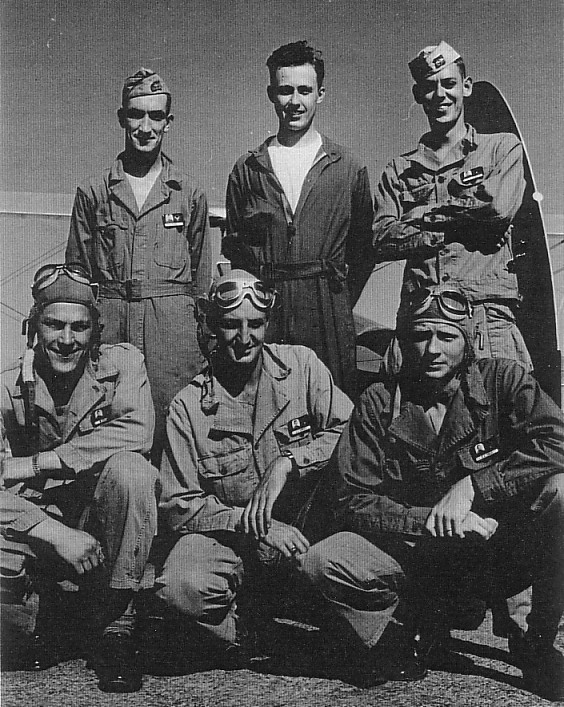
19?? - Art in the middle in the back row
Others are unidentified.
The Japanese attack on Pearl Harbor on December 7, 1941 altered those plans. Our country declared war and all eligible males were required to register for the draft. Programs such as the R.O.T.C., C.P.T.P., and the Civilian Conservation Corps helped fill the early need for recruits in the military. Industrial plants geared up to fill military supply requirements and the U.S. began training its allies for return to their country's armies and air forces. Back in Winfield the Armour Co. began sending production to military bases, and Strother Field - a U.S. Air Corps basic flying airfield - was built eight miles south of town. It was named Strother Field after one of old Dr. Strother's three sons was killed in the Pacific soon after the bombing of Pearl Harbor while flying a Boeing 4 engine bomber, a B-17 known as the "Flying Fortress". Having an airfield this close to Winfield certainly depleted the eligible stock of local girls! Courted by cadets from all over the country, they married and moved away as they followed their husband's career. This was repeated time and again all over the country.
As an instructor in Wichita, I was assigned to a contract government flight school, and in 1943 was sent to Arizona to fly as an instructor at Thunderbird Field near Scottsdale (now the Scottsdale Municipal Airport). Thunderbird was an Army Air Corps primary flight school where the cadets received their first 40 hours of flight training: 20 hours "dual" or with an instructor, and 20 hours solo time. They either passed this course or they "washed out" (flunked), and would join the army or another branch of the service. We flew open cockpits, single-engine, fabric covered Stearman Biplanes as trainers. They were ruggedly built which was essential for this type of training.
In 1945 I was released from instructing and permitted to fly transport planes - C-46's and C-47's - for the China National Aviation Company (C.N.A.C.) out of Calcutta, India. Pan American Airlines and C.N.A.C. had a joint airline operation, flying a government contract. We carried supplies from India over the "Hump" (Himalayan Mountains) into China, supplying our allies - the national government of China under the leadership of Chiang Kai-shek - with war material. One incident I recall vividly took place when I and several other pilots were delivering five AT6's - a single engine plane - from Calcutta to Shanghai. The plane contained fairly marginal navigational equipment and weather conditions that day were lousy. Clouds and pouring rain obscured our visibility. We'd been flying quite awhile and refueling was beginning to get crucial. We began searching for a landing strip and realized we were lost; a terrible and frightening conclusion. Coming as I did from a religious background, I began to pray silently that we would find our way. Within moments, clouds cleared enough to afford a peek below, and there beneath us in the distance was a Chinese Air Force landing strip. We landed safely and spent a couple of nights before taking off again. The memories I have of my years as a pilot with C.N.A.C. and of the friendships made, hold a special place in my heart. I owe lifelong thanks to Butch Norman, my dearest friend during those years and since.
Someone once asked me if I felt my situation was "average" during WWII. The word "average" mainly meant to me: what were the "odds on average" that I would survive my next flight! I was not average as it applied to military pilot training, because I had been trained in the C.P.T.P. prior to the war and had already accumulated several hundred hours of training before I ever sat in a military aircraft. Also, my experience was not "average" because I was required to wear corrective lenses when flying due to my eyesight, and pilots at the time were required to have 20/20 vision. I returned to the U.S. in late 1947 and decided to take up residence in Arizona. Much to my disappointment, I was unable to fly commercial airliners because my eyesight did not meet airline company standards. I'd flown supplies over the Hump under the worst conditions possible, yet could not get a position as a commercial pilot!
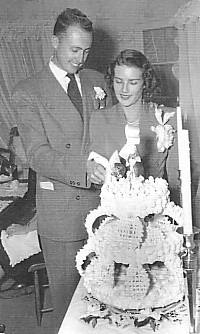
Our Wedding Day - February 21, 1948
I went to work as a sales representative for Dean and Fran Stanley, owners of the Stanley Fruit Company, a respectable produce business that supplied top-quality vegetables to major grocery stores throughout the U.S. Shortly after I arrived in Phoenix I met a beautiful lady and two little children. Her name was Anndel Nairn (my nickname for her was "Missy", even though others called her "Sissy"), and we met, fell in love and married February 21, 1948. Her former husband, Lauren Dwight Dreisbach from Laurens, SC was a pilot who had also been at Thunderbird Field. Unfortunately, less than 3 years after their marriage, he was killed in the crash of a fighter plane in 1943. His son Max Coe Dreisbach was barely one year old, and his daughter, Lauren Dwight Dreisbach (named after her father) was as yet unborn at the time of his death. Anndel and I had five more children, bringing our "total count" to seven. It has always been a source of pride that Max, who I introduced to flying, has flown with Trans World Airlines nearly 35 years now, has accumulated over 20,000 flying hours, and has been a T.W.A. Captain approximately 10 years!)
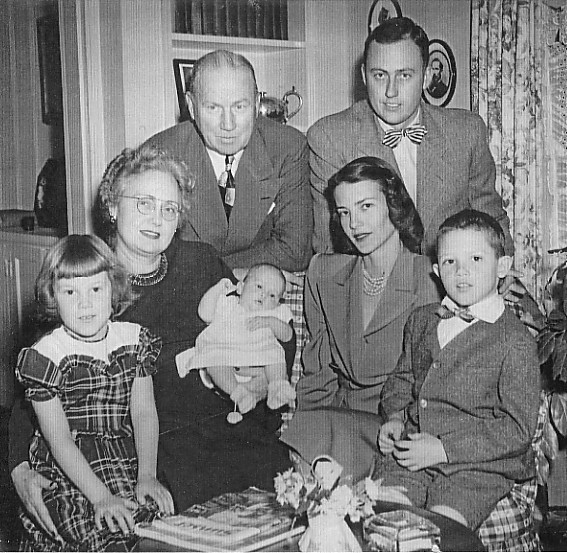
1949 - My parents, Missy and me with our growig family.
Front row, left to right: Our daughter, Lauren Dwight Dreisbach, my mother Patricia ("Pat") Skinner Kininmonth, our infant daughter, Heidi, my wife Missy, our son Max Coe Dreisbach.
Back row, left to right: My father, George Stuart Kininmonth and me.
In Phoenix I became involved in local politics and was a member of the Arizona Charter Government Committee which was instrumental in getting Barry Goldwater elected to the City Council; the beginning of his long and illustrious political career. Both Anndel and I were community oriented and involved in a number of organizations. I was a member of the Chamber of Commerce, Director and Chairman of the P.E. Committee at the local Y.M.C.A., a member of the local P.T.A., active in the Elk's Club, a member of the Quiet Birdman organization, and a member of the Farm Equipment Dealers Association. In 1956 I ran for the Arizona State Legislature but dropped out when my father died suddenly of a heart attack. Anndel did quite a bit of volunteer work as a member of the Phoenix Junior League, and February 3, 1948 she graced the cover of LOOK magazine after having been named "Junior Leaguer of the Year".
Like most of my friends, I've worn many hats over the years. While in Arizona I owned ½ of the Fergusun Tractor Dealership, and was a partner in a machinery manufacturing business with my friend, Reading Overstreet. I left the Stanley Fruit Co. to become a sales representative for the H.C. Shaw Co. a distributor of farm machinery, and I later became sales manager for Anderson Aviation, which distributed Piper aircraft throughout Arizona and Sonora, Mexico. I was lured back to H.C. Shaw when they offered me the position of Sales Manager at their Stockton, CA based company in one of the richest agricultural valleys in the world, the San Joaquin Valley. Missy and I moved our family to California in the fall of '62, and both became involved in civic activities.
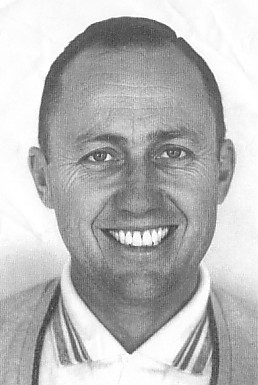
Circa 1970 - Me
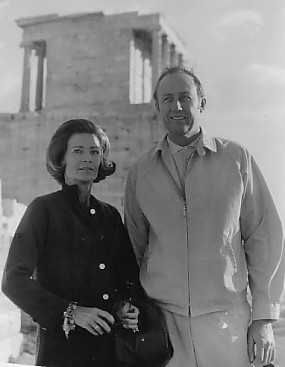
1970 - Missy and me in Greece
I've always believed people were placed on this earth for the purpose of making it better, and this I have tried to do. I served on the San Joaquin Aviation Committee 23 years, (since its inception in 1977) and often worked as a volunteer to bring Air Expo to the city, in an effort to recruit top pilots from all over the world. A highlight of my life was when my grandson, Travis Belt, my daughter Lauren's son, came to the air show as part of the U.S. Army Golden Knights Parachute Team in 1997. Travis parachuted and then M.C.'d the show afterward. During their presentation he and his team called me to the stage and presented me with the Golden Knights baton! I also served on the Chamber of Commerce Agriculture Expo. Committee, the Y.M.C.A., was a member of the city's Safe Neighborhood Action Group (S.N.A.G.), and worked for H.C. Shaw nearly 20 years before retiring.
Anndel and I raised our children, traveled extensively, and lived in Stockton 33 years before cancer claimed her life December 30, 1995. We had 9 grandchildren when she passed away, and another was born two years later. I remained in Stockton another 5 ½ years, and in April 2001 moved to Mt. Pleasant, SC to be near my youngest daughter, Patricia, and two granddaughters. My other children: Max, Heidi, Anndel, Gilbert and George, live in New Jersey, California, and Idaho. Sadly, our eldest daughter, Lauren, passed away from cancer on July 26, 1993, just shy of her 49th birthday.
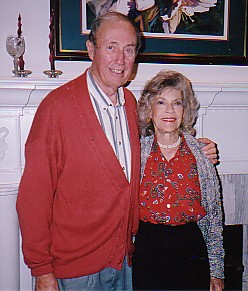
1995 - Missy and me
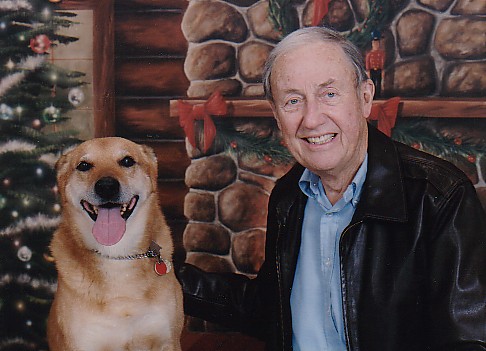
December 1996 - A couple of ol' dogs.
Me & my dog, Happy
I have been in sales pretty much all my life. I've sold produce, real estate, and hand gloves from China and Taiwan, farm equipment and supplies, airplanes, and tried to market one or two novel ideas. I think I lost money on the gloves and novel ideas, but never lost my belief in the value or usefulness of what I sold. Selling wasn't easy work, but it was a job I enjoyed and with a large family it was necessary. Many people, when they think of a salesman, think of Willie Lohman, the quintessential dreamer made famous by Arthur Miller. I am sure a fair share of dreams have collected dust somewhere on the well-stocked shelves of my life, but I have tried to make the most of every opportunity and situation that has come along. My children tell me I am a "man who knows no strangers"; that I am just as likely to see someone I know a thousand miles from home as I am at the neighborhood supermarket. I'd have to say they're right.
January 30, 2002
The following information, pictures and captions come from a lifetime friend of Art's, Jack "J.J." Banks
"Art and I were grade school friends beginning about 1936. We both grew up together in Winfield, Kansas. Art was born in Los Angeles, I in Ft. Worth. I came to Winfield in 1925. I have some photos of our boyhood, trip after the war to England to a reunion of Brits that Art trained at Thunderbird before he went to "The Hump". Art and "Sissy" were good friends and travelling companions of ours. I know most of his children."
(Jack - thanks for your contribution of information and photos.)

Dorothy and J.J. Banks
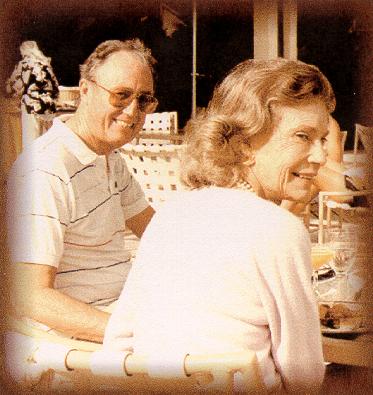
Art and lovely wife, Sissy dinning at The Spinnaker at Treasure Cay, Abaco ,Bahamas with the Banks'.
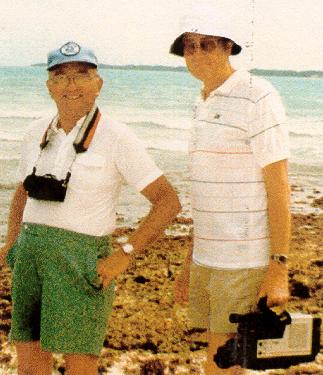
J.J. Banks and Arthur Kininmonth comb the beach near Treasure Cay on the Island of Abaco, Bahamas
(Christmas of 1987)
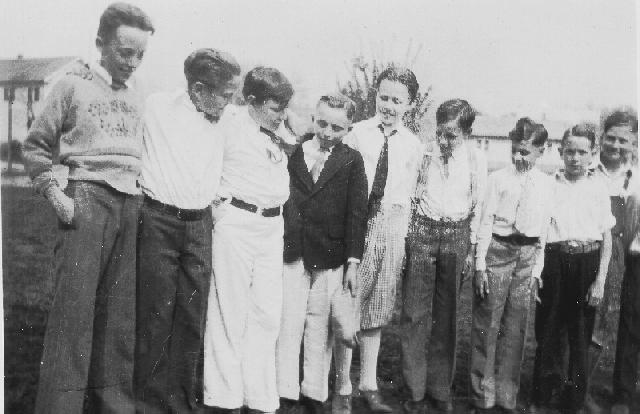
Fourth from left is J.J. Banks, then Arthur Kininmonth is next.
This was a birthday party on April 18, 1931 on J.J.'s eleventh birthday.
Arthur's eleventh birthday was ten days earlier on April 8, 1931.
This group of boys was in Junior High School at Winfield High School, Winfield, Kansas.
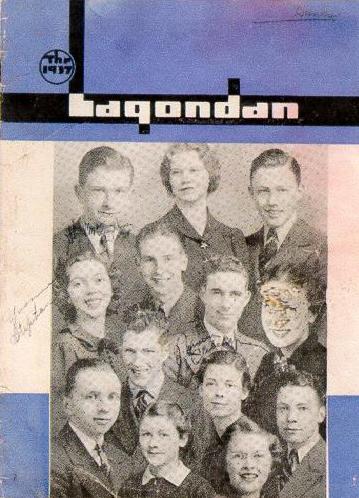
Front page of the 1937 Winfield High School Annual "Lagondan".
Art Kininmonth, a leader in the Class of 1937 is seen in the upper right corner.
(His friend, J.J. Banks is at the lower left corner.)
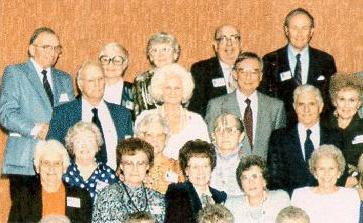
In 1987 at the Fifty Year Reunion of the
Class of 1937 of Winfield High. Art Kininmonth is at the upper right corner and J.J. Banks at the upper left.












